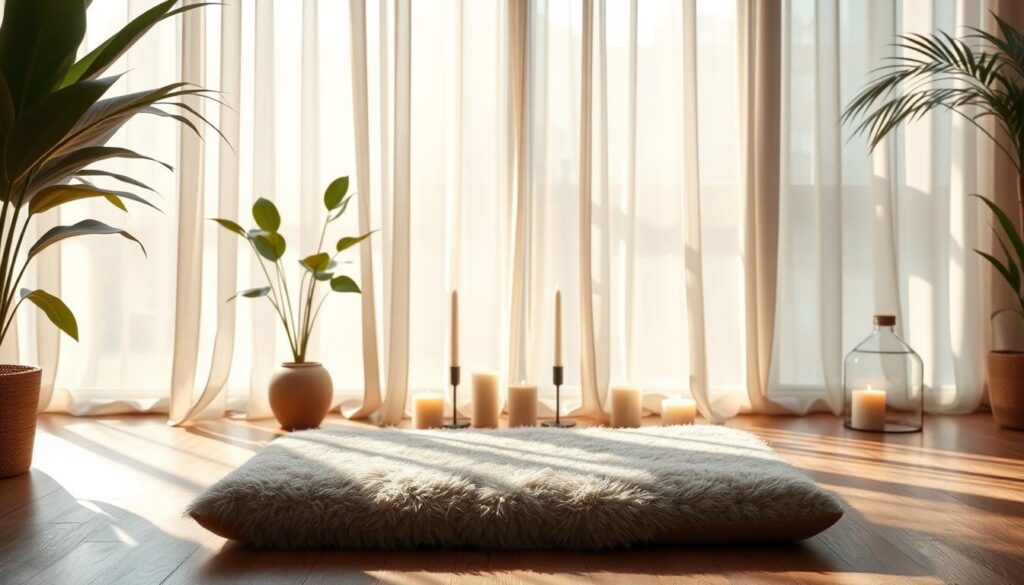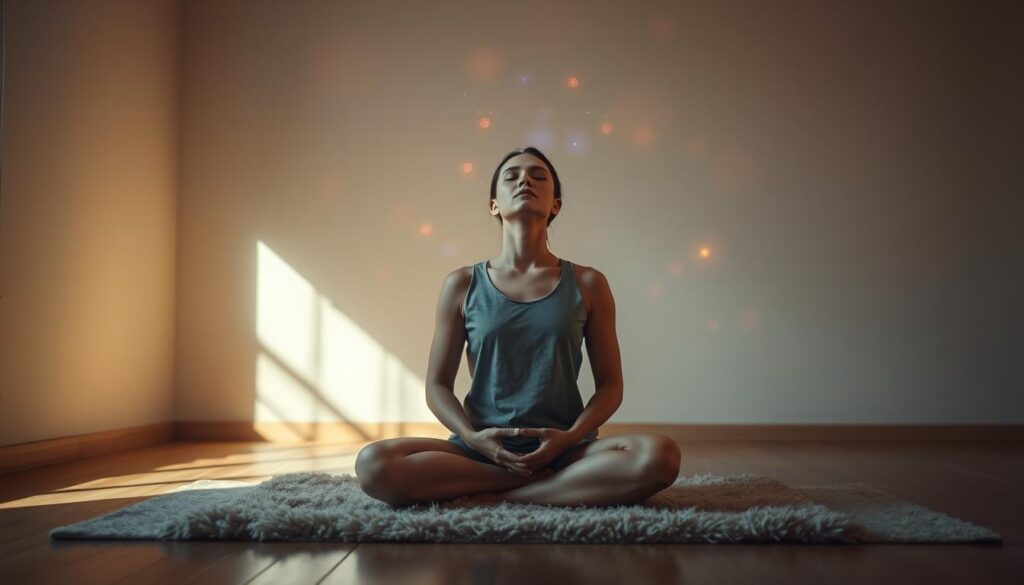Did you know 84% of adults feel stressed? In today’s fast world, finding peace seems hard. But meditation can help us face life’s challenges with ease. As a beginner, starting this journey might seem tough. Yet, with the right techniques, you can find deep inner peace.
Meditation helps us focus our minds for calm and clarity. It trains us to concentrate and think less. By focusing on our breath, we become more mindful and aware. Meditation isn’t a magic fix, but it helps us make better choices for ourselves and others. With patience, kindness, and a comfy spot, you’re ready to start your meditation practice.
Key Takeaways:
- Meditation offers a powerful solution to navigate life’s challenges and find inner peace.
- Focusing the mind and redirecting thoughts towards the breath cultivates mindfulness and awareness.
- Patience, self-kindness, and a comfortable space are the essential tools for beginning a meditation practice.
- Incorporating meditation into daily life can lead to better choices for oneself, family, and community.
- Breath awareness, body scan meditation, guided visualization, mantra repetition, and progressive muscle relaxation are effective meditation techniques for beginners.
Understanding the Benefits of Meditation
Meditation is a powerful practice that offers many benefits for our minds and bodies. By adding meditation to our daily routine, we can reduce stress, become more self-aware, improve our emotional health, and focus better.
Reducing Stress and Anxiety
Meditation is great for reducing stress and anxiety. It helps us find peace in the midst of chaos. Studies show it can help with conditions like irritable bowel syndrome, PTSD, and fibromyalgia.
It also lowers anxiety, helping those with social anxiety, fears, and obsessive-compulsive behaviors. Meditation calms the mind, helping us manage stress and stay emotionally balanced.
Enhancing Self-Awareness and Emotional Well-being
Meditation helps us understand our thoughts, emotions, and behaviors better. This self-awareness lets us spot and change negative patterns. It also makes us more compassionate, improving our relationships and emotional well-being.
Meditation has been shown to enhance compassion, self-understanding, and increase positive feelings and actions towards others.
Regular meditation practice makes us more positive and emotionally resilient. It helps us handle challenges and stay peaceful, even when things get tough.
Improving Focus and Concentration
In today’s world, it’s easy to get distracted. Meditation helps us focus and stay attentive for longer. It trains the mind, improving our willpower and productivity.
Research shows meditation boosts cognitive abilities like memory and mental clarity. It’s great for fighting age-related memory loss and dementia. It also helps us stay focused on tasks for longer.
| Benefit | Description |
|---|---|
| Stress Reduction | Meditation decreases symptoms of stress-related conditions like IBS, PTSD, and fibromyalgia. |
| Improved Focus | Regular meditation enhances memory, mental clarity, and attention span. |
| Emotional Well-being | Meditation cultivates compassion, self-understanding, and positive emotions. |
| Better Sleep | Meditation may improve sleep quality by reducing the time it takes to fall asleep. |
Adding meditation to our daily routines brings many benefits for our mental, emotional, and physical health. It helps us reduce stress, become more self-aware, improve our emotional health, and focus better. Meditation is a powerful tool for personal growth and transformation.
Creating a Comfortable Meditation Space
Starting my meditation journey, I see how key a peaceful spot is. A cozy meditation area greatly aids in sticking to a routine and enjoying mindfulness fully.
Choosing a Quiet and Peaceful Environment
Finding a quiet spot in my home is my first step. Even in my 400-square-foot apartment, I found a calm corner. It’s away from busy areas and gadgets, ensuring peace.
A cluttered space can lead to a cluttered mind. Research shows that women living in cluttered homes have higher levels of cortisol, a stress hormone, and may experience difficulty focusing or feelings of depression and fatigue.
Setting Up a Dedicated Meditation Area
Now, I design my meditation space. I fill it with objects that bring calm and support my meditation. Here are some of my favorites:
| Item | Description | Price |
|---|---|---|
| Ethel Studio Meditation Cushion | Handmade in Minnesota, these zero-waste cushions provide comfort and support during meditation sessions. | $148 |
| I Am & Co Affirmation Card Deck | Made in the USA, this deck of affirmation cards offers daily inspiration and motivation for my practice. | $15 |
| Ume Incense Holder and Sticks | Handcrafted incense holder and plant-based incense sticks create a soothing, aromatic atmosphere. | £10+ |
With these elements, my meditation area is now a cozy haven. It helps me focus, lowers stress, and boosts my well-being.
As I keep making my space my own and use tools like the Balance app, I’m sure my meditation will grow. I’m excited to see how mindfulness will change my life.
Establishing a Regular Meditation Practice
Starting my meditation journey showed me how crucial a regular practice is. Being consistent is key to enjoying meditation’s benefits. Adding it to my daily routine has changed my life.

I began with just two minutes of meditation each day for a week. It was easy to fit into my schedule. As I went on, I slowly increased my time to 10 minutes a day by the second month.
| Week | Daily Meditation Duration |
|---|---|
| Week 1 | 2 minutes |
| Week 2 | 4 minutes |
| Week 3 | 6 minutes |
| Week 4 | 8 minutes |
| Month 2 | 10 minutes |
Morning meditation became my daily routine. It gave me a calm start to the day. Find a time that fits your life, whether it’s lunch or before bed.
Guided meditations helped me as a beginner. They kept me focused and on track. Being part of an online meditation community gave me support and motivation.
Meditation trains the mind like exercise trains the body. Regular practice brings peace, clarity, and well-being.
I also started practicing mindfulness in everyday activities. This included deep breathing before tasks and being present while eating. These practices made meditation’s benefits spread into my daily life.
Starting small and being consistent is key to a lasting meditation practice. With regular effort, you’ll see meditation’s powerful effects.
Breath Awareness Meditation
As I start my breath awareness meditation, I settle into a comfy spot. My body relaxes, and my mind quiets down. With each deep breath, I feel grounded and present.
Focusing on the Sensations of Breath
I close my eyes and focus on my breath. I feel the air moving in and out, my chest and belly rising and falling. These sensations bring me calm and peace.
Experts say to practice mindful breathing for 15 minutes a day. Doing this regularly helps me handle tough times better. It’s a skill that grows stronger with practice.
| Breathing Technique | Benefits |
|---|---|
| Diaphragmatic Breathing | Influences the nervous system, especially in stress-related situations |
| Pranayamic Breathing (Dirga Pranayama) | Reduces frequency of asthma attacks and lessens the need for medication |
| 4-7-8 Breathing | Reduces breathlessness, anxiety, and depression in individuals with moderate COPD |
| Nadi Shodhana Pranayama | Decreases systolic and diastolic blood pressure in participants with hypertension |
Dealing with a Wandering Mind
My mind starts to wander during my practice. Thoughts and memories try to distract me. But I gently bring my focus back to my breath.
Mindfulness involves acknowledging and redirecting a wandering mind back to the breath during practice.
With each breath, I accept and judge myself less. I let thoughts pass like clouds, without getting caught up. This practice helps me stay present and focused, even when distracted.
Ending my meditation, I appreciate the effort I’ve made. Each time I focus on my breath, I connect deeper with myself. I find more peace and well-being.
Body Scan Meditation
I’m drawn to body scan meditation for inner peace and self-discovery. This technique, started by Jon Kabat-Zinn, PhD in the 1970s, focuses on the present moment. It helps me release tension and feel more relaxed.

Bringing Attention to Different Parts of the Body
I choose a comfortable position and close my eyes. With each breath, I focus on different body parts, starting from the head to the toes. I notice any sensations without trying to change them.
This practice helps me understand my body better. It teaches me to accept all sensations, good or bad. This way, I develop a closer relationship with myself and feel more compassionate.
Releasing Tension and Promoting Relaxation
As I continue, I find areas of tension. Instead of fighting it, I explore it with curiosity. I breathe into these spots, imagining them relax.
Studies show body scan meditation can lessen chronic pain. Regular practice trains my body to relax. It improves my health in the short and long term.
| Benefit | Description |
|---|---|
| Stress Reduction | Studies indicate that 60% to 80% of primary care visits are related to stress. Body scan meditation helps address anxiety and relieves stress. |
| Pain Management | Mindful awareness through body scan meditation assists patients in managing chronic pain and tension. |
| Accessibility | Individuals can practice body scan meditation nearly anywhere, at any time, as a stress-relief technique. |
After body scan meditation, I focus on my body breathing. I open my eyes feeling more present and calm. I carry this peace with me back into my day.
Body scan meditation is a powerful tool for cultivating mindfulness, releasing tension, and promoting deep relaxation. By bringing attention to the sensations within our bodies, we foster a greater sense of self-awareness and emotional well-being.
Guided Visualization Meditation
Guided visualization can help if you struggle to focus on your breath alone. It uses audio recordings or apps to guide you. These tools offer step-by-step instructions and gentle reminders to keep you focused and relaxed.
Let your imagination guide you in guided visualization meditation. You might picture a bright sun or a calm candle flame. Choose something that makes you feel peaceful and content.

Remember, consistency is key in guided visualization meditation. Regular practice can improve your life in many ways. It can boost your athletic performance, reduce anxiety, and help you sleep better.
“Visualization is really important. I believe in it. I believe we often create through visualization. When you catch yourself thinking negative thoughts, start painting a picture of what it is you want to have happen.”
– Dwayne Johnson
Studies show that visualization meditation is beneficial for well-being:
- Amihai & Kozhevnikov (2015) found that it helps stay alert and focused during meditation.
- Goyal et al. (2014) showed it promotes emotional balance and reduces stress.
- Vieiten et al. (2018) found it boosts creativity by engaging the imagination.
Visualization meditation also helps with focus and self-image. It can make you feel more confident and overcome self-doubt (Blankert & Hamstra, 2017).
| Visualization Technique | Benefits |
|---|---|
| Color Breathing | Improves stress relief and mood |
| Compassion Meditation | Fosters feelings of compassion and kindness toward oneself and others |
| Progressive Muscle Relaxation | Eases muscle tension related to anxiety and stress |
| Guided Imagery | Helps visualize positive scenes for relaxation and stress management |
| Goals Visualization | Aids in achieving goals by creating new pathways in the brain through neuroplasticity |
Exploring guided visualization meditation is a personal journey. Trust your intuition and try different techniques. Enjoy the process of finding inner peace and unlocking your potential.
Mantra Repetition Meditation
At first, meditation was tough for me because I got distracted easily. That’s when I started using mantra repetition meditation. It helped me focus and find inner peace by silently repeating a meaningful phrase or sound.

Studies show mantra meditation can reduce distractions and improve mood. Just 5 to 20 minutes a day can make a big difference. It helps me stay present and focused.
Choosing a Meaningful Phrase or Sound
Mantra meditation is simple and flexible. You can pick any word, phrase, or sound that means a lot to you. Some favorites include:
- “Om” – a sacred sound in many spiritual traditions
- “Peace” – a reminder to cultivate inner tranquility
- “I am present” – an affirmation of being fully in the moment
- “Love” – a word that evokes feelings of compassion and connection
Think about what you want to achieve with your mantra. What qualities do you want to have? What state of mind do you aim for? Choosing a mantra that aligns with your goals makes it easier to stick with it.
Silently Repeating the Mantra
After picking your mantra, it’s time to use it in your meditation. Sit comfortably, close your eyes, and breathe deeply. Then, silently repeat your mantra, letting the words flow smoothly through your mind.
Recite the word or phrase of choice in your mind softly, as if the soft sounds were coming from the center of the mental object in the middle of your abdomen. Recite the word or phrase of choice continuously, while thinking of the bright mental object, gently and comfortably floating in your center.
When thoughts pop up, gently bring your focus back to the mantra. With practice, you’ll get better at staying focused and enjoy the benefits of mantra repetition meditation.
| Step | Duration | Description |
|---|---|---|
| 1 & 2 | 1-2 minutes each | Settle into your meditation posture and begin silently repeating your mantra |
| 3 | 3-5 minutes | Continue repeating the mantra, allowing your mind to settle into a rhythm |
| 4 | 5-15 minutes | Maintain focus on the mantra, gently redirecting your attention when thoughts arise |
Mantra repetition has changed my meditation practice for the better. It calms my mind, quiets my thoughts, and brings me peace. With regular practice, you can experience these benefits too.
Walking Meditation
Walking meditation is a powerful mindfulness practice. It helps me stay present in my daily life. By walking mindfully, I connect more with my body, breath, and surroundings.
Whether I’m walking to my car or strolling through a park, it’s a chance for inner peace. These moments help me discover more about myself.

When I start walking meditation, I let myself wander freely. I trust my instincts and feel liberated. With every step, I focus on the present, noticing more around me.
I stop to feel my body and the world around me. This makes the experience richer.
I notice small details like bird songs and scents. I see colors and textures. This deepens my mindfulness and appreciation for the moment.
“In every walk with nature, one receives far more than he seeks.” – John Muir
Sometimes, my mind wanders during meditation. I gently bring it back to my steps and body. This keeps me grounded and focused.
To get the most from walking meditation, I walk slowly. I notice how weather and surroundings affect me. After walking, I reflect on how it made me feel.
| Walking Meditation Guidelines | Benefits |
|---|---|
| Engage in walking meditation for about 10 minutes | Provides a manageable time frame for the practice |
| Practice in increments of 30-60 seconds for each cue | Offers a structured approach to maintain focus |
| Observe physical sensations, sounds, smells, and surroundings | Promotes a holistic approach to mindfulness |
| Focus on the rhythm of the soles of the feet touching the ground | Enhances grounding and connection with the present moment |
| Adapt the steps to fit your walk and preferences | Encourages flexibility and personalization of the practice |
Walking meditation has changed my life. It brings me peace and renewal. With each step, I connect more with myself and the world, finding presence and well-being.
Loving-Kindness Meditation
More people are turning to loving-kindness meditation for inner peace and compassion. Studies show nearly 60% of people use it to soften their minds and improve well-being.
Loving-kindness meditation, or Metta meditation, is a Buddhist practice. It involves sending positive thoughts to oneself and others. Practitioners repeat phrases to feel love, compassion, and goodwill for all.
Cultivating Compassion and Goodwill
It starts with loving oneself. This is key because loving others is easier when we love ourselves first. A survey found 75% practice for self-compassion and self-acceptance.
“If your compassion does not include yourself, it is incomplete.” – Jack Kornfield
During meditation, people use phrases like “May I be happy. May I be well.” These phrases help soften the heart and build compassion.
Extending Loving-Kindness to Oneself and Others
After building self-compassion, we extend kindness to others. This includes friends, family, and even strangers. We repeat the loving-kindness phrases for them.
Studies show loving-kindness meditation improves relationships and well-being. A 2015 review found it boosts positive emotions. A 2021 trial showed it helps with PTSD and depression.
| Benefit of Loving-Kindness Meditation | Percentage of Practitioners Experiencing Benefit |
|---|---|
| Increased Self-Compassion | 78% |
| Enhanced Positive Emotions | 65% |
| Improved Relationships | 52% |
| Greater Sense of Connection to Others | 47% |
With practice, even hard feelings like anger soften. Mindfulness and compassion help us find peace and emotional strength.
Loving-kindness meditation connects us to our own and others’ goodness. It helps us create a more loving world, one meditation at a time.
Progressive Muscle Relaxation
Exploring meditation, I found progressive muscle relaxation (PMR) to be incredibly beneficial. Edmund Jacobson introduced it in the 1930s. It involves tensing and relaxing muscles to reduce tension and promote relaxation.
To start, I sit or lie down comfortably. I tense my feet, then move up to my head, holding each muscle for 5-10 seconds. This helps me release body tension.
Research shows PMR can lower anxiety, stress, and improve sleep. A 2019 study found it reduced depression, anxiety, and stress in unemployed people. It also improved their well-being and life quality.
PMR is as good as acupuncture in reducing tension and anxiety, a 2016 study found. It can also help with COVID-19 anxiety, a 2020 study suggested. A 2020 study showed it decreased anxiety and improved sleep in burn patients.
PMR’s benefits go beyond mental health. A 2013 study found it helped with chronic neck pain. It also reduced low back pain in pregnant women when used with music, a 2018 study found.
Systematically Tensing and Relaxing Muscle Groups
Effective PMR involves tensing and relaxing muscles systematically. I start with my feet, tensing for 5-10 seconds, then release. I move up to my calves, thighs, and so on, ensuring all tension is released.
Practicing PMR has made me more aware of my body’s sensations. I can now easily spot and release tension in areas like my shoulders or jaw. This awareness has been a key benefit.
PMR can be particularly helpful when practiced alongside cognitive-behavioral therapy or medication for individuals experiencing mild to moderate anxiety.
Adding PMR to my daily routine has been transformative. I practice for 15 to 20 minutes in a quiet spot, wearing comfy clothes. Using voice recordings or guided sessions helps me stay focused.
PMR has been a powerful tool in my meditation journey. It helps me release tension, reduce stress and anxiety, and find inner peace.
Meditation Techniques for Beginners
Starting with meditation can be simple. Even a few minutes a day can help. It’s all about being consistent. Meditating a bit each day can make you feel better and less distracted.
Simple and Accessible Practices for Getting Started
For beginners, try focusing on your breath, scanning your body, or repeating a mantra. These methods don’t need special tools or experience. They help you find calm and focus.
Studies show meditation lowers stress and anxiety. It also improves sleep and emotional health. Regular practice can make a big difference.
“Meditation is a way of befriending ourselves and our experiences.” – Jon Kabat-Zinn
Building a Sustainable Meditation Habit
Starting can be tough, but be patient and kind to yourself. It’s okay if your mind wanders. Tools like earplugs or music can help you stay focused.
To keep meditating, start small and grow gradually. It’s better to meditate a little every day than a lot less often. Sit comfortably and use guided sessions for help.
| Meditation Technique | Benefits | Duration |
|---|---|---|
| Breath Awareness | Reduces stress, improves focus | 5-10 minutes |
| Body Scan | Releases tension, promotes relaxation | 10-15 minutes |
| Mantra Repetition | Calms the mind, enhances concentration | 5-10 minutes |
There’s no one right way to meditate. Simple techniques and regular practice can change your life. Start your journey to self-discovery and peace today.
Overcoming Common Challenges in Meditation
Starting my meditation journey, I found it wasn’t easy. Many beginners face obstacles that test their patience. But, I learned these challenges are part of the journey. With the right mindset and techniques, we can overcome them.
Dealing with Distractions and Restlessness
One big challenge is when our minds wander. Studies say we spend 40-50% of our time thinking about the past or future. This constant thinking can be tiring and hard to stop.
Physical discomforts like cramps or itchiness can also distract us. It’s key to remember these feelings are normal. We should acknowledge them without judgment and focus on our breath or meditation object.
Letting Go of Expectations and Judgment
Expectations and self-judgment are big hurdles in meditation. Feeling frustrated when our minds wander is common. But, it’s vital to meditate with an open mind, ready for whatever happens.
The five hindrances in mindfulness practice include desire, anger, restlessness, sleepiness, and doubt. By recognizing these hindrances when they appear and gently letting them go, we can cultivate a more accepting and compassionate attitude towards ourselves and our practice.
Meditation is a skill that grows with time and patience. By showing up and doing our best, we improve our focus and inner peace. So, let go of self-judgment, see challenges as growth opportunities, and trust in meditation’s power.
Integrating Meditation into Daily Life
Starting my meditation journey showed me mindfulness benefits go beyond sitting still. It changed my daily life, making every moment more present and aware.
I’ve learned to bring mindfulness into my daily tasks. Brushing teeth, eating, or walking, I focus on the sensations. This helps me appreciate the simple things more.
In today’s world, finding calm is hard. But, short meditation breaks help me stay centered. A few deep breaths or a mantra can make a big difference.
Mindfulness is not about removing ourselves from life, but about embracing it fully, with all its joys and challenges.
Meditation has also improved my relationships. It helps me understand my emotions and those of others better. This leads to deeper, more empathetic connections.
| Meditation Technique | Benefits |
|---|---|
| Mindfulness Meditation | Increased self-awareness, emotional regulation, improved focus and concentration |
| Gratitude Meditation | Calms the mind, fosters appreciation for positive aspects of life |
| Consistent Meditation Practice | Reduces anxiety, improves relaxation, enhances overall well-being |
My meditation journey is unique. I use apps, yoga, and nature to find peace. The key is to be open and present.
Mindfulness has brought me peace and connection. It helps me handle life’s ups and downs. Every breath reminds me of the power of being present.
Conclusion
Looking back on my meditation journey, I see how it has changed me. It has led to inner peace and personal growth. I’ve learned to handle stress better and focus more. Each meditation session makes me more mindful and present.
It hasn’t been simple, but I’ve learned to be kind to myself. I celebrate small wins and cherish quiet moments. Resources like guided meditations for beginners have helped me grow.
Meditation is a powerful tool for well-being and happiness. If you’re looking to reduce stress or improve focus, it’s worth trying. Remember, being consistent and dedicated is crucial. Every moment of meditation is an investment in your personal growth and inner peace.
In today’s fast-changing world, staying updated is key. Just as meditation changes us, knowing the latest in technical SEO helps us in the digital world. Mindfulness and smart online strategies can help us grow personally and professionally.
FAQ
What are some simple meditation techniques for beginners?
Beginners can try breath awareness, body scan, or mantra repetition. These are easy to learn and don’t need special equipment. You can do them anywhere, anytime.
How can I create a comfortable space for meditation at home?
Choose a quiet spot at home for meditation. A corner of your bedroom or a cozy nook works well. Add calming objects like candles, incense, or plants to create a peaceful atmosphere.
What are the benefits of practicing meditation regularly?
Regular meditation lowers stress and anxiety. It boosts self-awareness and emotional health. It also improves focus and concentration. Plus, it fosters compassion and empathy, leading to better relationships.
How long should I meditate as a beginner?
Start with short meditation sessions, just a few minutes a day. Increase the time as you get more comfortable. Focus on regular practice, not the length of each session.
What should I do when my mind wanders during meditation?
It’s normal for your mind to wander. Gently bring your focus back to your chosen meditation object. Be patient and kind to yourself as you practice.
Can I use guided meditations to help me focus?
Yes, guided meditations are great for beginners. They offer instructions and gentle reminders. Try different ones to find what works best for you.
How can I integrate mindfulness into my daily life?
Bring mindfulness to daily activities by focusing on the present. Notice your senses when eating or walking. These simple practices can make meditation’s benefits last all day.
What should I do if I experience physical discomfort during meditation?
Adjust your posture or use props if you’re uncomfortable. If it doesn’t help, take a break or try a different position. Meditation should be relaxing, not painful.
How can I stay motivated to maintain a regular meditation practice?
Set achievable goals and celebrate your progress. Join a meditation group or find a partner for support. Keep your initial motivation in mind. With time, you’ll see meditation’s benefits in your life.

